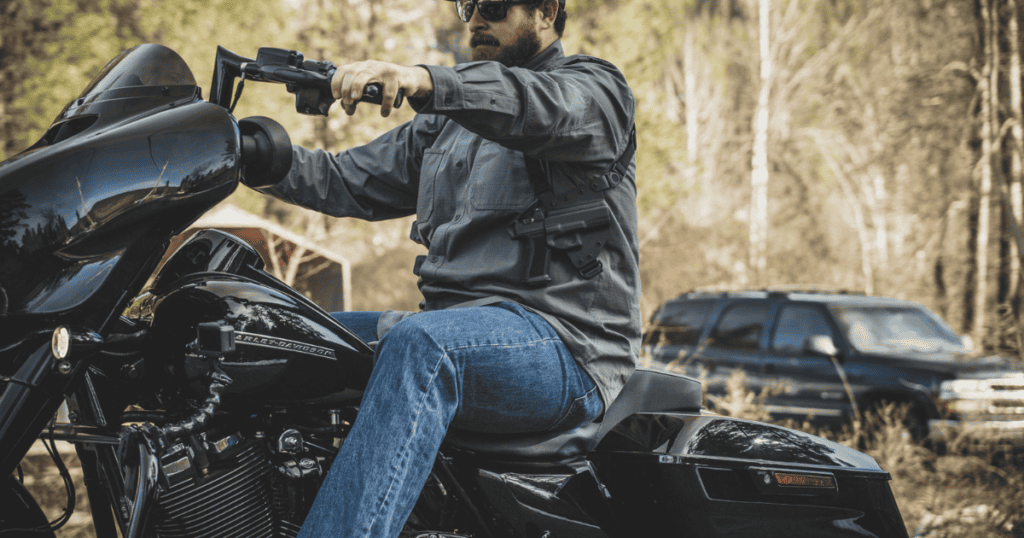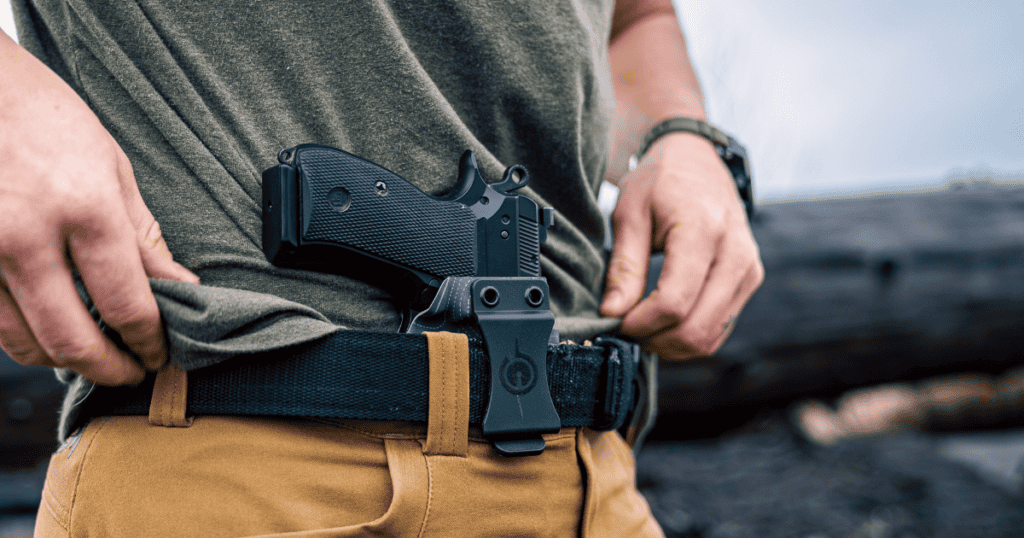Whether you’re out on the trail, behind the wheel, or carrying every day, your holster needs to fit your routine – not the other way around. But with so many styles out there, how do you choose between a chest holster, shoulder holster, or hip holster?
What to Consider When Choosing a Holster
Choosing the right holster is personal, but a few factors can help you narrow it down. Here’s what to think about:
Comfort for Long-Term Wear
If you’re wearing a holster for hours, comfort matters. But keep in mind that comfort depends on body type, firearm size, and holster design. It’s worth experimenting to find what fits your lifestyle.
- A chest holster spreads the weight evenly across your upper body, which is great for long treks or outdoor use.
- Shoulder holsters also shift weight away from the waist, making them comfortable for people who spend a lot of time seated.
- Hip holsters keep your firearm right where your hand naturally rests, making them easy to draw from.
Tip: Try different styles with your usual clothing to see what feels natural.
Accessibility and Draw Speed
How fast can you draw when you need to? That depends on where your holster sits and how you move. Each setup will feel different in a real-world situation.
- Chest holsters offer quick access with both hands free.
- Shoulder holsters work well when seated or wearing layers.
- Hip holsters (especially OWB) are usually the fastest for most people because your hand rests near your side.
Concealability
For concealed carry permit holders, staying discreet is a big deal.
- Chest holsters are built more for open carry and aren’t ideal if concealment is a priority.
- A shoulder holster might give you better access when seated, but you’ll need a jacket or outer layer to keep it covered.
- OWB hip holsters are harder to conceal unless you’re wearing something loose.
- Inside-the-waistband (IWB) holsters are the most popular for staying hidden under a shirt.
To learn more about concealed carry and your clothes, read Concealed Carry in Any Outfit, How to Conceal Carry in Formal Wear, and Activewear and Concealed Carry.
Intended Use
What are you doing while carrying? This is a huge part of choosing the right setup.
- Hiking or hunting? A chest holster keeps your firearm out of the way and is easy to access on the trail.
- Everyday carry? You might want something discreet like an IWB or a slim OWB holster.
- Tactical or duty use? A shoulder or hip holster that supports heavier firearms and gear might be better.
Just remember to start with your priorities: comfort, access, concealment, or use. Then try a setup that checks the most boxes.
Now let’s break down each holster individually.
Chest Holsters

A chest holster is designed to sit high and center on your torso, giving you fast, front-body access to your firearm.
This setup shines in outdoor or active environments where backpack straps, waist belts, or heavy gear make other holster styles harder to manage.
Benefits of a Chest Holster
- Comfort while seated: A chest holster stays out of the way when you’re on an ATV or behind the wheel. It doesn’t dig into your side or get buried under a seatbelt.
- Great for the backcountry: When hiking or horseback riding, a chest rig keeps your firearm in reach without interfering with a backpack or bino harness.
- Quick access under pressure: In a high-stress moment, you don’t want to fight through layers or awkward angles. Chest carry lets you draw fast with either hand if needed.
Drawbacks to Consider
- Not ideal for everyday urban carry: A chest holster is more at home on a trail than at a gas station. In towns and cities, it can draw unwanted attention.
- Won’t fit under most everyday clothing: Unless you’re wearing a heavy coat, chest carry is tough to conceal. It’s not made for t-shirts and hoodies.
Chest Holster Spotlight: The Kenai
The Kenai Chest Holster is purpose-built for the backcountry.
It’s designed to ride comfortably with backpacks, chest rigs, and hip belts, so it won’t get in the way when you’re on the move. Whether running, fly fishing, or mountain biking, the Kenai keeps your firearm secure and right where you need it.
Handmade in the U.S. and trusted by hunters and outdoor professionals, it’s a solid choice when comfort and quick access matter most.
Need to Run a Bino Harness Too?
The Bino Link Holster connects with your bino harness if you carry both a firearm and binoculars.
It keeps your setup streamlined and secure with no extra straps to tangle or shift. It is perfect for hunters or wildlife watchers who want quick access to both tools without sacrificing comfort or mobility.
To learn more, read Carrying a Pistol with a Bino Harness.
Can You Conceal Carry with a Chest Holster?
Technically, yes. But realistically, it’s made for open carry. The design isn’t subtle, and it will print or be completely visible unless you’re bundled up.
Check out our Concealed Carry Shoulder Holster Guide for more help.
Shoulder Holsters

A shoulder holster spreads the weight of your firearm and spare mags across both shoulders, balancing the load and taking pressure off your waist.
It’s a solid choice for carrying larger handguns, especially when belt space is limited, or you’re seated most of the day.
Benefits of a Shoulder Holster
- Comfort while seated: Whether driving or working at a desk, a shoulder rig stays out of the way and keeps your side clear.
- Even weight distribution: Spreading the load across your shoulders takes the pressure off your lower back and hips, which is great for carrying full-size firearms and extra magazines.
- Layer-friendly carry: In cooler weather or when you’re already wearing a jacket, shoulder carry keeps your setup tucked in and discreet.
Drawbacks to Consider
- Slower draw under stress: You’ll need to reach across your body, sweep back your jacket, and avoid flagging yourself. That takes practice.
- Wardrobe restrictions: These holsters need an outer layer for concealment. Without it, you’re either open-carrying or printing badly.
- Not comfy for everyone: Some people find shoulder rigs awkward, especially if they’re not adjusted right or worn over long hours.
Shoulder Holster Spotlight: The Spectre
The Spectre Shoulder Holster is a modern take on a classic setup.
It’s fully modular, built to balance comfort and retention, and fits snugly without needing tie-downs. Whether you’re in plainclothes security, driving long distances, or just want a way to carry off the waist, the Spectre is designed to move with you – not against you.
Is a Shoulder Holster Good for Concealed Carry?
Yes, if you’re wearing the right clothing. Shoulder holsters work well under jackets, coats, or suit coats, making them popular in colder climates or jobs where dressing up is part of the routine. But they’re not ideal for hot weather or minimalist wardrobes.
Waist Holsters (OWB & IWB)

Waist holsters are the go-to choice for most firearm owners, especially for everyday concealed carry.
They come in two main styles:
- OWB (Outside the Waistband): The holster sits on the outside of your belt. It’s easier to access and more comfortable, especially for larger firearms.
- IWB (Inside the Waistband): The holster sits between your body and waistband. It’s better for deep concealment and stays hidden under regular clothes.
Benefits of Waist Holsters
- Great for concealed carry: Especially with IWB holsters, you can easily hide your firearm under a t-shirt or hoodie.
- Fast access: With a bit of practice, drawing from the waist is quick and instinctive.
- Versatile: Waist holsters are easy to integrate into your daily routine, whether you’re wearing jeans, work pants, or even gym clothes.
Drawbacks to Consider
- Not always comfy while seated: Sitting for long periods can make a waistband holster dig into your side.
- Printing risk: Bigger firearms or thin clothing will make OWB setups stick out. A well-fitted IWB holster helps reduce this.
Waist Holster Spotlight: Ronin, Solace, and Wraith
We offer several solid waist carry options, each designed for real-world use:
- Ronin OWB Concealment Holster: A clean, minimalist OWB holster that rides close to the body. Great for open carry or concealed carry with a cover garment.
- Solace Hybrid IWB: Combines Kydex retention with a flexible backer for added comfort. A smart choice if you carry all day and want less pressure on your skin.
- Wraith IWB: A straightforward, no-frills IWB holster built for comfort, concealment, and confident draws.
Read Ronin vs Sentinel vs OWB Holsters to learn more.
Which Holster Position Is Best: IWB or OWB?
That depends on you. If concealment is the goal, IWB is hard to beat. If comfort and speed matter more, OWB might be a better fit. Ultimately, the right position is the one that fits your routine, your body, and your firearm without getting in the way. Try different placements and see what feels the most natural.
For more help, check out IWB vs. OWB Holsters: Which Is Best for You?
Side-by-Side Comparison
If you’re deciding between setups – like a chest holster vs. shoulder holster or comparing shoulder vs. hip holster styles – this chart gives you a clear side-by-side view of what each option does best (and where it might fall short).
| Feature | Chest Holster | Shoulder Holster | Waist Holster (OWB/IWB) |
| Concealability | Low | Moderate | High |
| Comfort When Seated | High | High | Moderate |
| Quick Access | High | Moderate | High |
| Best For | Hunting, Hiking, Backcountry | Driving, Cold Weather, Security | Everyday Carry |
| Drawbacks | Visible, gear-specific | Wardrobe-reliant, slower draw | Possible discomfort |
One Size Doesn’t Fit All – And That’s a Good Thing
The best way to carry is the one that feels natural, stays comfortable, and keeps you prepared. There’s no single “best” holster for everyone. Just the one that fits your life.
Want to see what works for you? Explore the full GunfightersINC holster lineup and try each style firsthand.
